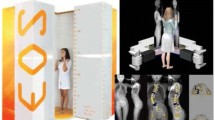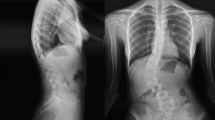Abstract
The aim of the study was to investigate the mechanisms of the Cheneau-Toulouse-Munster (CTM) brace in the correction of scoliotic curves, at night in the supine position. Magnetic resonance imaging (MRI) and Computer tomography (CT) acquisitions were performed in vivo on eight girls having an idiopathic scoliosis and being treated for the first time using a personalised CTM brace. Personalised 3D finite element models of the spine were developed for each patient, and an optimisation approach was used to quantify the forces generated by each brace on each scoliotic spine. A sensitivity study was undertaken to test the assumptions about intervertebral behaviour and load transmission from the brace to the spine. The computed CTM brace forces were 9-216N in the coronal plane and 2-72N in the sagittal plane. Personalised spinal stiffness properties should be included in spine models because, in this study, partial correction resulted from the application of higher estimated forces than for total correction. Partially reduced spines should be stiffer than totally reduced spines. The sensitivity study showed that the computed brace forces were proportional to the intervertebral Young's modulus and should be analysed as estimated data. Better knowledge of brace forces should be helpful in brace design to achieve the best correction of first scoliotic deformities.
Similar content being viewed by others
References
Aaro, S., Bustrom, R., andDahlbom, M. (1981): ‘The derotating effect of Boston brace: a comparison between computer tomography and a conventional method’,Spine,6, pp. 477–482
Andriacchi, T. P., Schultz, A., Belytschko, T., andDewald, R. L. (1976): ‘Milwaukee brace correction of idiopathic scoliosis’,Bone Joint Surg.,58, pp. 806–815
Asher, M. A., andCook, L. T. (1995): ‘The transverse plane evolution of the most common adolescent idiopathic scoliosis deformities’,Spine,20, pp. 1386–1391
Aubin, C. E., Labelle, H., Ruszkowski, A., Petit, Y., Gignac, D., Joncas, J., andDansereau, J. (1999): ‘Variability of strap tension in brace treatment for adolescent idiopathic scoliosis’,Spine,24, pp. 349–354
Barrau, J. J., Chambord, O., Gay, D., andNuc, M. (1985): ‘Homogénéisation en torsion d'une poutre composite’. Troisiéme coloque sur les tendances actuelles en calcul de structure, Bastra, Pluralis, pp. 283–296
Belytschko, T. B., Andriacchi, T. P., Schultz, A. B., andGalante, J. O. (1973): “Analog studies of forces in the human spine: computational techniques’,J. Biomech.,6, pp. 361–371
Chase, A. P., Bader, D. L., andHoughton, G. R. (1989): ‘The biomechanical effectiveness of the Boston brace in the management of idiopathic scoliosis’,Spine,14, pp. 636–642
Cobb, J. R. (1948): ‘Outline of the study of scoliosis’. Instructional course lectures: the American academy of orthopaedic surgeons, Ann Arbo, JW Edwards,5, pp. 264–275
Cochran, T., Nachemson, A. L. F. (1985): ‘Long-term anatomic and functional changes in patients with adolescent idiopathic scoliosis treated with the Milwaukee brace’,Spine,10, pp. 127–133
Gignac, D., Aubin, C. E., Dansereau, J., andLabelle, H. (2000): ‘Optimisation method for 3D bracing correction of scoliosis using a FE model’,Eur. Spine,9, pp. 185–190
Labelle, H., Dansereau, J., Bellefleur, C., andPoitras, B. (1996): ‘Three-dimensional effect of the Boston brace on the thoracic spine and the rib cage’,Spine,21, pp. 59–64
Jiang, H., Raso, V., Hil, D., Durdle, N., andMoreau, M. (1992): ‘Interface pressure in the Boston brace treatment for scoliosis: a preliminary study’ inDansereau, J. (Ed.): ‘International Symposium on 3D Scoliotic Deformities’ (Editions de l'ecole Polytechnique and Gustav Fischer Verlag, Stuttgart, 1992), pp. 395–399
Mulcahy, T., Galante, J., DeWald, R., Schultz, A. B., andHunter, J. C. (1973): ‘A follow-up study of forces acting on the milwaukee brace on patients undergoing treatment for idiopathic scoliosis’,Clin. Orthopaed. Related Res.,93, pp. 53–68
Panjabi, M., Brand, R., andWhite, A. (1976): “Three-dimensional flexibility and stiffness properties of the human thoracic spine’,J. Biomech.,9, pp. 185–192
Patwardan, A. G., Li S., Gavin, T., Lorenz, M., Meade, K. P., andZindrick, M. (1990): ‘Orthotic stabilization of thoracolumbar injuries, a biomechanical analysis of the Jewett hyperextension orthosis’,Spine,15, pp. 654–661
Périé, D., andHobatho, M. C. (1998): ‘In vivo determination of contact areas and pressure of the femorotibial joint using non linear finite element analysis’,Clin. Biomech.,13, pp. 394–402
Périé, D., Sales De Gauzy, J., Sévely, A., andHobatho, M. C. (2001): ‘In vivo geometrical evaluation of CTM brace effect on scoliotic spine using MRI method’,Clin. Biomech.,16, pp. 129–137
Périé, D., Sales de Gauzy, J., Baunin, C., andHobatho, M. C. (2001): ‘Tomodensitometry measurements forin vivo quantification of mechanical properties of scoliotic vertebrae’,Clin. Biomech.,16, pp. 373–379
Schultz, A. B., Haderspeck, K., andTakashima, S. (1981): ‘Correction of scoliosis by muscle stimulation, biomechanical analysis’,Spine,6, pp. 468–476
Shinoto, A., Ohtsuka, Y., andInoue, S. (1987): ‘Three-dimensional analysis of the effect of brace treatment on idiopathic scoliosis’ (Gustav Fisher Verlag, Stuttgart, 1987), pp. 113–130
Stokes, I. A. F., andLaible, J. P. (1990): ‘Three-dimensional osseoligamentous model of the throax representing initiation of scoliosis by asymmetric growth’,J. Biomech.,23, pp. 589–595
Sundaram, S. H., andFeng, C. C. (1977): ‘Finite element analysis of the human thorax’,J. Biomech. 10, pp. 505–516
Viviani, G. R., Ghista, D. N., Lozada, P. J., Dubbaraj, J. K., andBarnes, G. (1986): ‘Biomechanical analysis and simulation of scoliosis surgical correction’,Clin. Orthopaed. Related Res.,208, pp. 40–47
Willers, U., Normelli, H., Aaro, S., Svensson, O., andHedlund, R. (1993): ‘Long-term results of Boston brace treatment on vertebral rotation inidiopathic scoliosis’,Spine,18, pp. 432–435
Wynarsky, G. T., andSchultz, A. B. (1991): ‘Optimization of skeletal configuration: studies of scoliosis correction biomechanics’,Biomech.,24, pp. 721–732
Yoganandan, N., Kumaresan, S. C., Voo, L., Pintar, F. A., andLarson, S. J. (1996): ‘Finite element modelling of the C4-C6 cervical spine unit’,Med. Eng. Phys.,18, pp. 569–574
Author information
Authors and Affiliations
Corresponding author
Rights and permissions
About this article
Cite this article
Périe, D., De Gauzy, J.S. & Hobatho, M.C. Biomechanical evaluation of Cheneau-Toulouse-Munster brace in the treatment of scoliosis using optimisation approach and finite element method. Med. Biol. Eng. Comput. 40, 296–301 (2002). https://doi.org/10.1007/BF02344211
Received:
Accepted:
Issue Date:
DOI: https://doi.org/10.1007/BF02344211




